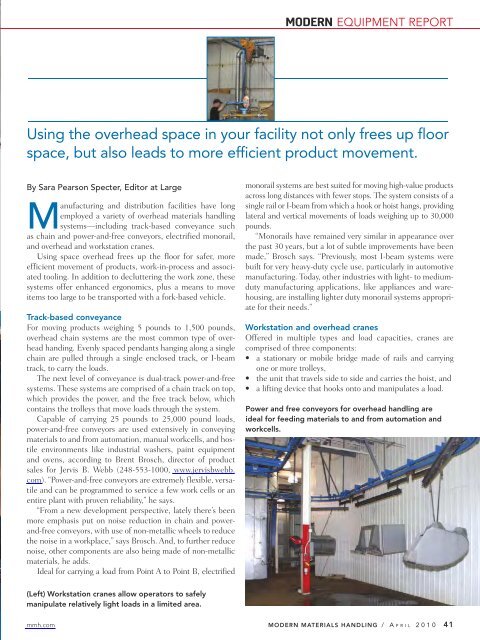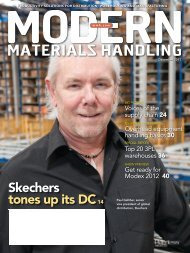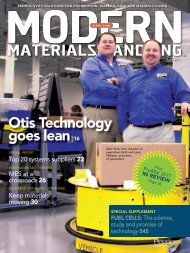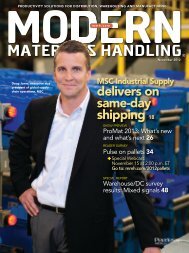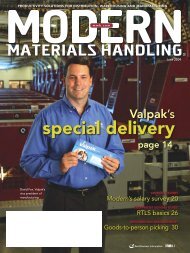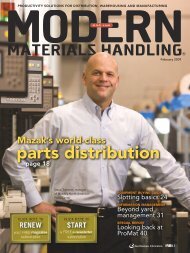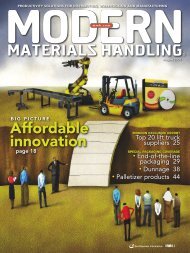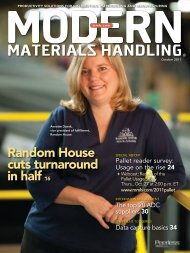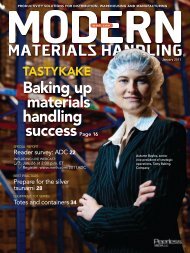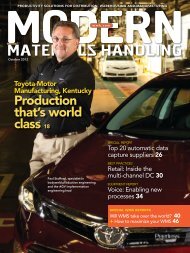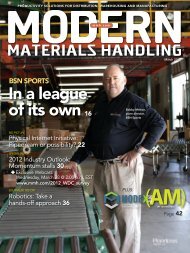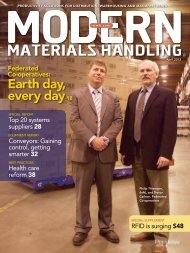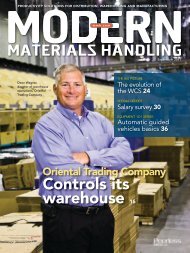Modern Materials Handling - April 2010
Modern Materials Handling - April 2010
Modern Materials Handling - April 2010
- No tags were found...
You also want an ePaper? Increase the reach of your titles
YUMPU automatically turns print PDFs into web optimized ePapers that Google loves.
EQUIPMENT REPORTUsing the overhead space in your facility not only frees up floorspace, but also leads to more efficient product movement.By Sara Pearson Specter, Editor at LargeManufacturing and distribution facilities have longemployed a variety of overhead materials handlingsystems—including track-based conveyance suchas chain and power-and-free conveyors, electrified monorail,and overhead and workstation cranes.Using space overhead frees up the floor for safer, moreefficient movement of products, work-in-process and associatedtooling. In addition to decluttering the work zone, thesesystems offer enhanced ergonomics, plus a means to moveitems too large to be transported with a fork-based vehicle.Track-based conveyanceFor moving products weighing 5 pounds to 1,500 pounds,overhead chain systems are the most common type of overheadhanding. Evenly spaced pendants hanging along a singlechain are pulled through a single enclosed track, or I-beamtrack, to carry the loads.The next level of conveyance is dual-track power-and-freesystems. These systems are comprised of a chain track on top,which provides the power, and the free track below, whichcontains the trolleys that move loads through the system.Capable of carrying 25 pounds to 25,000 pound loads,power-and-free conveyors are used extensively in conveyingmaterials to and from automation, manual workcells, and hostileenvironments like industrial washers, paint equipmentand ovens, according to Brent Brosch, director of productsales for Jervis B. Webb (248-553-1000, www.jervisbwebb.com). “Power-and-free conveyors are extremely flexible, versatileand can be programmed to service a few work cells or anentire plant with proven reliability,” he says.“From a new development perspective, lately there’s beenmore emphasis put on noise reduction in chain and powerand-freeconveyors, with use of non-metallic wheels to reducethe noise in a workplace,” says Brosch. And, to further reducenoise, other components are also being made of non-metallicmaterials, he adds.Ideal for carrying a load from Point A to Point B, electrifiedmonorail systems are best suited for moving high-value productsacross long distances with fewer stops. The system consists of asingle rail or I-beam from which a hook or hoist hangs, providinglateral and vertical movements of loads weighing up to 30,000pounds.“Monorails have remained very similar in appearance overthe past 30 years, but a lot of subtle improvements have beenmade,” Brosch says. “Previously, most I-beam systems werebuilt for very heavy-duty cycle use, particularly in automotivemanufacturing. Today, other industries with light- to mediumdutymanufacturing applications, like appliances and warehousing,are installing lighter duty monorail systems appropriatefor their needs.”Workstation and overhead cranesOffered in multiple types and load capacities, cranes arecomprised of three components:• a stationary or mobile bridge made of rails and carryingone or more trolleys,• the unit that travels side to side and carries the hoist, and• a lifting device that hooks onto and manipulates a load.Power and free conveyors for overhead handling areideal for feeding materials to and from automation andworkcells.(Left) Workstation cranes allow operators to safelymanipulate relatively light loads in a limited area.mmh.com MODERN MATERIALS HANDLING / A P R I L 2 0 1 0 41


